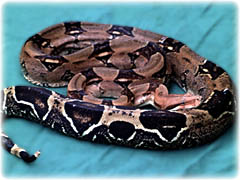Difference between revisions of "Boa constrictor"
Jump to navigation
Jump to search
| (7 intermediate revisions by 4 users not shown) | |||
| Line 1: | Line 1: | ||
| − | {{ | + | {{OpenPagesTop}} |
| − | [[Image:Boa_constrictor_240x180.jpg|250px|thumb|right|'''Boa constrictor''' | + | [[Image:Boa_constrictor_240x180.jpg|250px|thumb|right|'''Boa constrictor''' (© RVC)]] |
==Introduction== | ==Introduction== | ||
The boa constrictor (''Boa constrictor'') is a common pet snake of the family Boidae. | The boa constrictor (''Boa constrictor'') is a common pet snake of the family Boidae. | ||
==Morphology== | ==Morphology== | ||
| − | They may grow to a length of about 4 metres (13 ft). Unlike many other boids they do not have heat-sensitive pits. The colouring tends to vary geographically but they tend to be a snake with brown or red saddles along the dorsum. There is a proliferation of names by hobbyists to describe colour forms. | + | They may grow to a length of about 4 metres (13 ft). Unlike many other boids they do not have [[Snake Special Senses|heat-sensitive pits]]. The colouring tends to vary geographically but they tend to be a snake with brown or red saddles along the dorsum. There is a proliferation of names by hobbyists to describe colour forms. |
==Free-Living== | ==Free-Living== | ||
*Distribution - Boa constrictors have a large natural range from Argentina in the south to northwestern Mexico. | *Distribution - Boa constrictors have a large natural range from Argentina in the south to northwestern Mexico. | ||
| Line 10: | Line 10: | ||
*Diet - Free-ranging boas are generalists. They feed on mammals and birds. | *Diet - Free-ranging boas are generalists. They feed on mammals and birds. | ||
==Captivity== | ==Captivity== | ||
| − | Boa constrictors are very popular as pets. Captive-bred ones are less likely to be aggressive and are easier to keep. | + | Boa constrictors are very popular as pets. Captive-bred ones are less likely to be aggressive and are easier to keep, but are prone to inclusion body disease. |
*Cage – They require caging to reflect their size. | *Cage – They require caging to reflect their size. | ||
*Temperature - a temperature range of 25-30°C is adequate. | *Temperature - a temperature range of 25-30°C is adequate. | ||
| Line 16: | Line 16: | ||
*Diet - Boas usually feed well on dead rodents. | *Diet - Boas usually feed well on dead rodents. | ||
*Reproduction – Boas are viviparous and may produce up to 50 young after a gestation period of 5-8 months. | *Reproduction – Boas are viviparous and may produce up to 50 young after a gestation period of 5-8 months. | ||
| + | |||
| + | {{Learning | ||
| + | |literature search = [http://www.cabdirect.org/search.html?q=(od:(Boa+constrictor)+OR+title:(Boa+constrictor)+OR+ab:(Boa+constrictor))&fq=sc:%22ve%22 Boa constrictor publications] | ||
| + | }} | ||
| + | |||
| + | |||
| + | {{review}} | ||
| + | |||
| + | {{OpenPages}} | ||
| + | |||
| + | |||
[[Category:Snake_Species]] | [[Category:Snake_Species]] | ||
| + | [[Category:Lizard_and_Snake_Glossary]] | ||
Latest revision as of 03:06, 20 July 2018
Introduction
The boa constrictor (Boa constrictor) is a common pet snake of the family Boidae.
Morphology
They may grow to a length of about 4 metres (13 ft). Unlike many other boids they do not have heat-sensitive pits. The colouring tends to vary geographically but they tend to be a snake with brown or red saddles along the dorsum. There is a proliferation of names by hobbyists to describe colour forms.
Free-Living
- Distribution - Boa constrictors have a large natural range from Argentina in the south to northwestern Mexico.
- Habitat - Boas may be arboreal or terrestrial. They are often seen along rivers.
- Diet - Free-ranging boas are generalists. They feed on mammals and birds.
Captivity
Boa constrictors are very popular as pets. Captive-bred ones are less likely to be aggressive and are easier to keep, but are prone to inclusion body disease.
- Cage – They require caging to reflect their size.
- Temperature - a temperature range of 25-30°C is adequate.
- Humidity - Humidity requirements are between 50-70%.
- Diet - Boas usually feed well on dead rodents.
- Reproduction – Boas are viviparous and may produce up to 50 young after a gestation period of 5-8 months.
| Boa constrictor Learning Resources | |
|---|---|
 Search for recent publications via CAB Abstract (CABI log in required) |
Boa constrictor publications |
| This article has been peer reviewed but is awaiting expert review. If you would like to help with this, please see more information about expert reviewing. |
Error in widget FBRecommend: unable to write file /var/www/wikivet.net/extensions/Widgets/compiled_templates/wrt6638ea2cb4a565_11866103 Error in widget google+: unable to write file /var/www/wikivet.net/extensions/Widgets/compiled_templates/wrt6638ea2cb832d7_48986509 Error in widget TwitterTweet: unable to write file /var/www/wikivet.net/extensions/Widgets/compiled_templates/wrt6638ea2cbb7fd4_72829560
|
| WikiVet® Introduction - Help WikiVet - Report a Problem |
